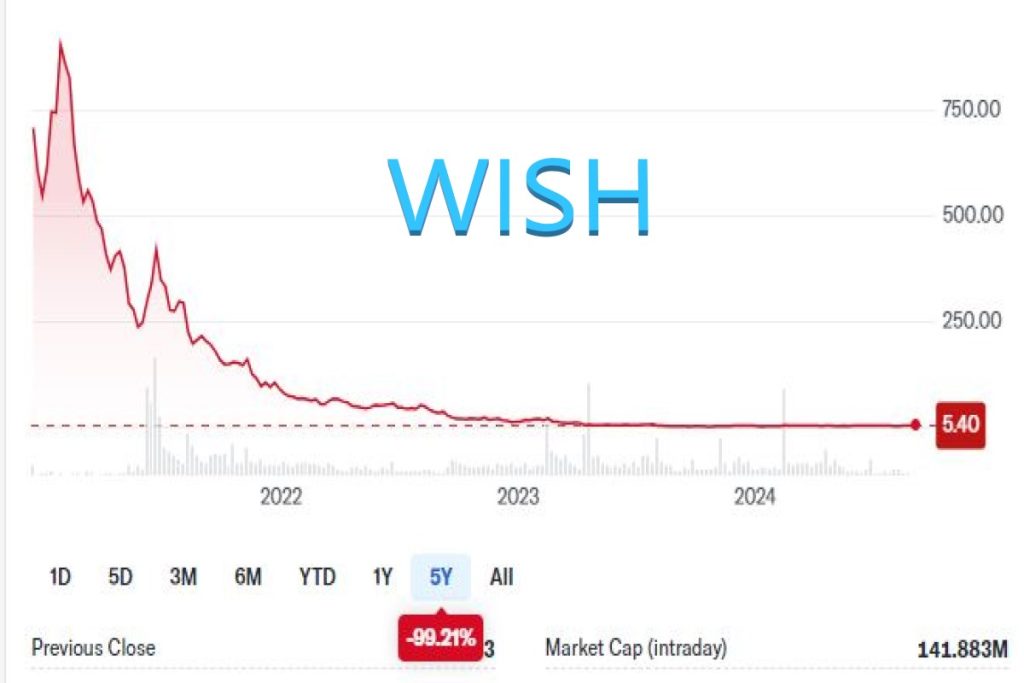ContextLogic Inc., the parent company of the e-commerce platform Wish, made its public debut on December 16, 2020, with an initial public offering (IPO) price of $24 per share. The company, known for offering a wide range of affordable products, quickly became a favorite among retail investors, especially during the meme-stock craze of early 2021.
Early Optimism and Rapid Decline
In the initial months following its IPO, Wish’s stock saw a brief period of optimism, reaching a peak of around $30 per share in January 2021. However, this optimism was short-lived. By early 2021, the stock began a steep decline, losing approximately 97% of its value from its peak. As of the latest data, Wish’s stock is trading at less than $1 per share.
Here is a great video by Company Man that covers most of the history:
Factors Contributing to the Decline
Several factors have contributed to the dramatic fall in Wish’s stock price:
- Quality and Logistics Issues: Wish’s business model, which relies heavily on low-cost products from China, faced significant challenges. Customers frequently complained about the quality of products and long shipping times. Competing platforms like Alibaba’s AliExpress and Pinduoduo’s Temu, with better logistics and quality control, have eroded Wish’s customer base.
- Financial Performance: Wish’s financial performance has been disappointing. The company has struggled to maintain its revenue and profitability metrics. For instance, in the second quarter of 2021, Wish reported a 6% year-over-year decline in revenue and a significant increase in net losses. The company’s sales have continued to decline, with an 80% drop year-over-year in the most recent quarter.
- Leadership Changes: The company has seen two changes in its CEO position over the past two years, adding to the instability and lack of clear strategic direction.
- Market Conditions: The broader macroeconomic environment has also been unfavorable for companies like Wish, which have no earnings history and rely heavily on consumer spending.
Comparison with Shein and Temu
When comparing Wish to its competitors Shein and Temu, several key differences and similarities emerge:
- Product Range and Quality:
- Wish: Offers a wide range of low-cost products, but often faces criticism for product quality and long shipping times.
- Shein: Primarily focuses on fashion and accessories, known for trendy and affordable clothing. Shein has a more streamlined supply chain, which helps in maintaining better quality control.
- Temu: Similar to Wish, Temu offers a broad range of products at low prices. However, Temu benefits from PDD Holdings’ extensive network of suppliers, which helps in providing a more reliable shopping experience.
- Shipping and Logistics:
- Wish: Often criticized for long shipping times and inconsistent delivery experiences.
- Shein: Generally offers faster shipping compared to Wish, with better tracking and customer service.
- Temu: Provides competitive shipping options, including free standard shipping on most orders and a late delivery credit policy.
- Financial Performance:
- Wish: Struggling with declining sales and profitability.
- Shein: Continues to grow rapidly, expanding its market presence globally.
- Temu: Relatively new but showing strong growth, leveraging its parent company’s resources and logistics network.
- Customer Experience:
- Wish: Mixed reviews, with many customers dissatisfied with product quality and delivery times.
- Shein: Generally positive reviews, especially for its fashion items, though some concerns about sustainability and ethical practices.
- Temu: Positive initial reception, praised for its wide product range and competitive pricing.
Current Status and Future Prospects
As of now, Wish’s stock is trading at a penny stock valuation, reflecting the market’s lack of confidence in the company’s ability to turn around its fortunes. Despite the low stock price, some investors see potential in the company’s large user base and global reach. However, significant improvements in product quality, logistics, and overall business strategy are essential for any meaningful recovery.
In conclusion, Wish’s journey since its IPO has been a tumultuous one, marked by initial excitement followed by a steep and sustained decline. The company’s future remains uncertain, with significant challenges to overcome before it can regain investor confidence and achieve sustainable growth. When compared to Shein and Temu, Wish faces tougher competition, especially in terms of product quality, logistics, and customer satisfaction.
What are your thoughts on Wish’s performance? Do you think they can turn things around?
